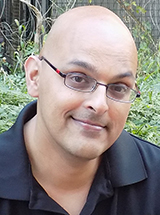 |
| Kushol Gupta |
Kushol Gupta, Research Asst. Professor
| Institution: | Perelman School of Medicine, University of Pennsylvania |
|---|---|
| Department: | Biochemistry and Biophysics |
| Room: | |
| Phone: | 267-259-0082 |
| Email: | kgupta@pennmedicine.upenn.edu |
| Web Page(s): | http://www.stwing.upenn.edu/~kgupta |
| Education: | University of Pennsylvania, Philadelphia, PA B.A. 05/1997 Biochemistry & Music University of Pennsylvania, Philadelphia, PA Ph.D. 06/2003 Pharmacology |
| Post Doctoral: | 2003-2010 Postdoctoral Fellow, Department of Biochemistry and Biophysics & HHMI, University of Pennsylvania School of Medicine, Philadelphia, PA 2005 Instructor, Human Evolution, University of the Arts, Philadelphia, PA 2007-2008 HHMI Postdoctoral Fellow, Department of Chemistry and Biochemistry, Swarthmore College, Swarthmore, PA 2010-2015 Research Associate, Department of Biochemistry and Biophysics, University of Pennsylvania School of Medicine, Philadelphia, PA |
| Other Faculty Positions: | 2016- Research Assistant Professor, Department of Biochemistry and Biophysics, University of Pennsylvania School of Medicine, Philadelphia, PA 2017- Faculty Director, Johnson Foundation Structural Biology and Biophysics Core, Perelman School of Medicine, University of Pennsylvania, Philadelphia, PA 2017- Member, Graduate Group in Biochemistry and Biophysics, Perelman School of Medicine, University of Pennsylvania, Philadelphia, PA |
| Awards and Academic Honors: | 2001-2002 American Heart Association Predoctoral Fellow, Pennsylvania-Delaware Affiliate 2002 Solomon Erulkar Traveling Fellowship (University of Pennsylvania) 2008-2010 amFAR/Mathilde Krim Fellow in Basic Biomedical Research |
Research Interest:
The Structural Biology of Retroviral Integrases. Retroviral integrase (IN) catalyzes the incorporation of viral cDNA into the host genome. The design of effective pharmacological treatments remains of paramount importance to the treatment of HIV/AIDS, and detailed structural models of intact IN oligomers in their various forms are essential to new structure-based drug design efforts. My work on the retroviral integrase (IN) has focused on the understanding of higher-order structure and oligomeric forms of the full-length integrase when bound to host factors and DNA, with the overall goal of determining the molecular details of the larger macromolecular assemblies that underlie the steps of retroviral integration and other stages of the viral life cycle. My contributions in this field have married X-ray crystallography and rigorous biophysical methods to approach these fundamental questions. These approaches have included the application of small angle X-ray and neutron scattering (SAXS/SANS), analytical ultracentrifugation, multi-angle light scattering, and molecular modeling. My contributions to-date have greatly informed the field’s understanding of the quaternary structure and stoichiometry of IN, IN-DNA, and IN-host factor assemblies, including experimental confirmation of the quaternary solution structure of the intasome indicated by crystallographic symmetry operations in the case of the prototype foamy virus integrase in complex with DNA.Most recently these approaches have been brought to bear on an exciting new class of allosteric inhibitors (“ALLINIs”) that are able to inhibit IN via selective modulation of its oligomeric properties. Surprisingly, ALLINIs interfere not with DNA integration but with viral particle assembly late during HIV replication. In 2016, we reported a breakthrough in the structural biology of HIV Integrase: the first crystal structure of HIV-1 Integrase in complex with the ALLINI GSK 1264. To our knowledge, this is the first time full-length HIV-1 integrase has been crystallized. The structure shows GSK1264 bound to the dimer interface of the catalytic domain, and also positioned at this interface is a C-terminal domain (CTD) from an adjacent IN dimer. In the crystal lattice, IN forms an open polymer mediated by this interaction. Further studies of a panel of ALLINIs show that HIV escape mutants with reduced sensitivity commonly alter amino acids at or near the inhibitor-mediated interface, and that HIV escape mutations often encode substitutions that reduce multimerization. We propose that ALLINIs inhibit particle assembly by stimulating inappropriate polymerization of IN through this CTD-catalytic-domain interface.
Structure and Mechanism of Site-Specific Recombinases. Early in my postdoctoral career in the Van Duyne group, I contributed to the structural and mechanistic study of the tyrosine recombinase Cre from bacteriophage P1 and the large serine integrase TP901-1 from Lactococcus lactis. This class of enzymes catalyze a variety of DNA manipulations, including integration and excision of viral genomes, resolution of multimeric genomes to promote faithful segregation, and control of gene expression. Many tyrosine and serine recombinases are active in mammalian cells and are powerful tools for genomic manipulation and the introduction of transgenes. My contributions to these ongoing studies have included application of X-ray crystallography, small angle scattering, analytical centrifugation, biochemical binding and activity assays, and genetic approaches towards mechanistic insights. These studies provide fundamental and detailed insights into the structure and mechanism of tyrosine and serine recombinases and will guide future efforts to engineer new tools for genomic manipulation.
